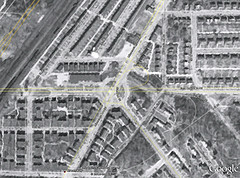The non-circles of Washington: Part 1
Washington, DC is well known for its traffic circles, but there have been many more circles proposed, partially constructed, and removed over the course of the city’s history than exist today. Let’s explore them.
(Please note that this is not meant to be a thorough analysis of the history of each circle. I owe a big thank you to Eric Fidler for help researching this topic.)
You’re probably familiar with Dupont, Logan, Scott, Thomas, and Washington Circles—the circles located inside the original L’Enfant city. Maybe you also know Chevy Chase, Grant, Randle, Sheridan, Sherman, Ward, and Westmoreland Circles—large circles located outside of the original city of Washington.
There are many other less prominent circles, such as Anna J. Cooper in LeDroit Park, Banneker in Southwest, Bass in Marshall Heights, Kalorama, Plymouth in Rock Creek Gardens, Tenley, and Thompson in Woodland-Normanstone, and even some so small they hardly merit a mention (Peace and Garfield Circles on the Capitol grounds, for example).
Our focus will be on three categories: missing circles, former circles, and proposed circles that never came to be.
First, let’s discuss the circles that were removed or changed to the point that they’ve basically lost their circleness. Barney, Ellicot, Hancock, Truxton, and the unnamed circle that existed at the intersection of East Capitol, Minnesota, and Ridge all fall into this category.
Barney Circle was located where Pennsylvania Avenue reached the west bank of the Anacostia. It was used as a turn-around point for streetcars. Today, the only thing that makes the spot look like a circle is the ramp from westbound Pennsylvania Avenue to the Southeast Freeway.
Ellicott Circle (click here and choose the Topo tab at the top of the page to see it labeled) was a proposed twin to Barney Circle on the eastern side of the Anacostia River. It’s not clear if it was ever built, but the name remained on the plat books for years (one could argue that the cloverleaf ramps at the Anacostia Freeway/Pennsylvania Avenue exit create multiple, small Ellicott Circles today).
Hancock Circle has a very interesting history, and there is fantastic documentation regarding its fate. According to extensive testimony before the House Committee on Appropriations regarding the District of Columbia Appropriation Bill for 1896, an Act of Congress in 1889 called for Hancock Circle to be created at the corner of 16th & U Streets and New Hampshire Avenue NW, provided the city could purchase the land from surrounding landowners. Those who owned property at the corner refused to sell, so the city created a small circle within the street right-of-way, which was ruled a “nuisance” because traffic had a difficult time traversing it.
Congress authorized moving the circle a couple blocks north to the intersection of 16th Street and Morris Street, a paper street halfway up the hill where Meridian Hill Park is today. This would have put the circle on a significant slope, so District employees lobbied to have the language authorizing the circle changed so it would be at the top of the hill. In the end, the circle was never rebuilt. The statue of General Winfield Scott Hancock, which was to grace the center of the circle, ended up being placed at 7th and Pennsylvania NW, where it remains today at the entrance to the Archives Metro Station.
Truxton Circle, which existed until 1947 at the intersection of North Capitol Street, Florida Avenue, Q Street, and Lincoln Road, is gone now. There have been rumblings about reconstructing it, but nothing more serious than a DDOT study has come out of this.
Finally, there was a circle at the corner of East Capitol Street, Minnesota Avenue, and Ridge Road for a time. It appears that it was removed when the Anacostia Freeway was constructed and East Capitol Street was placed in a trench underneath the intersection and the freeway. It’s visible on this aerial photograph from 1949.
Tomorrow, I’ll discuss proposed circles which never came to fruition and some of the partial circles in the city.




